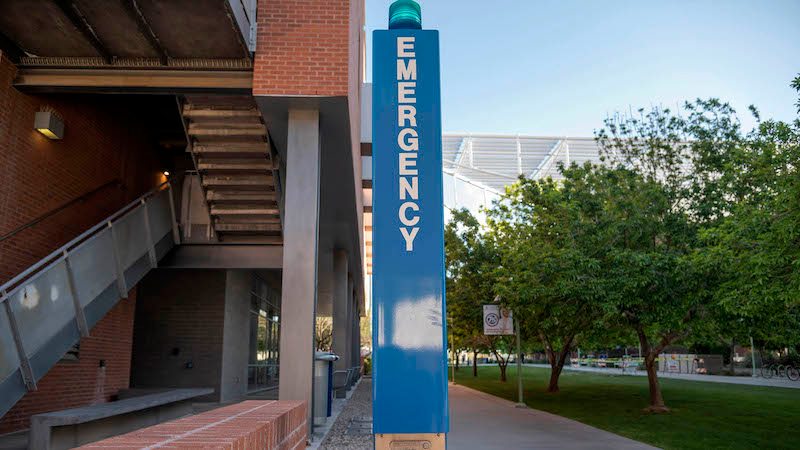University of Arizona implements enhanced security strategies


Victoria Rees
Share this content
The University of Arizona has announced a range of new security strategies to improve emergency preparedness, such as the installation of locks on classroom doors and simulated emergency exercises.
According to the university, the work is part of ongoing efforts to establish a more consistent and co-ordinated response from all on campus during a crisis.
Following the fatal on-campus shooting of Thomas Meixner, Head of the Department of Hydrology and Atmospheric Sciences in October 2022, the university has implemented certain recommendations to improve security.
“When I arrived at the University of Arizona, one of my first goals was to determine the physical updates that were needed to make campus safer,” said Steve Patterson, Interim Chief Safety Officer.
“At the same time, we need to make sure everyone on campus is educated about what to do in the event of an emergency, whether they are a student, a front-line employee, a faculty member or a leader.”
Crisis management
University President Robert C. Robbins and other executive members of the Critical Incident Response Team participated in training and a security strategies tabletop exercise in June.
Comprising 18 leaders across campus, the executive team provides general assessment of critical incidents and events and makes recommendations to the president regarding response and operations.
The team is also involved in recommending security strategies and actions to manage and resolve incidents, including activation of the Campus Emergency Operations Center, which is staffed by the CIRT working group.
During the training, members of the executive team studied a mock scenario and reviewed key roles and responsibilities, including activation of the Campus Emergency Operations Center and how members of the executive team receive real-time information during an emergency or crisis.
The group also reviewed the National Incident Management System and the Incident Command System, and discussed the importance of timely and co-ordinated dissemination of accurate information to key stakeholders and the public.
“The goal of this type of training is to strengthen the University of Arizona Campus Emergency Response Plan through an exercise scenario and facilitated discussion,” Patterson said.
“This is invaluable training that we plan to do on a regular basis.”
Safety readiness
In a separate activity to improve the university’s security strategies, leaders of the units that are part of the newly formed Office of Public Safety – including Facilities Management, the University of Arizona Police Department, the Office of Emergency Management, Risk Management Services and Parking & Transportation Services – met at the Campus Emergency Operations Center for a tabletop exercise and discussion surrounding emergency response.
“Participating in the training and tabletop exercise was an incredibly valuable experience for me,” Robbins said.
“This kind of training develops a mindset for emergency preparedness and it creates an ongoing dialogue for how we can best achieve campus safety readiness.
“With this and many other safety initiatives, we have made a lot of progress over these past few months, but there is still a lot of work to be done and like many members of our community, I am eager to continue this work.”
More security measures
In late June, representatives from several campus units joined colleagues from Pima Community College and Arizona State University at a three-day course titled “Crisis Management Affecting Institutions of Higher Education: A Collaborative Community Approach.”
The training on security strategies covered stakeholder relationships, crisis prevention and protection, recognizing risk, mitigation, recovery and crisis communications.
That was followed by an exercise for members of the Office of Emergency Management and University of Arizona Health Sciences to ensure the University’s Campus Emergency Response Plan aligns with the city and county emergency response plans.
Other security strategies that have taken place include:
- Members of the Campus Safety Commission have been meeting regularly. The group comprises faculty and staff members, students and community members. Its mission is to advise the university’s Chief Safety Officer on matters related to the development, implementation and evaluation of informed, inclusive and responsive safety policies and practices
- The Office of Emergency Management, Risk Management Services and Facilities Management worked with FM building managers to update 165 individual campus building emergency plans, which will be available to the campus community in the coming weeks
- Campus safety walk-throughs involving university leaders
- Locks are being installed on classroom doors
- All-hazards posters are being installed in classrooms
- Additional message boards are being installed in classrooms
- Several updates were made to the UAlert emergency notification system
- A Communications Advisory Group was formed. Members in include leaders and communications professionals from several central offices, including the Dean of Students office, Counseling & Psych Services, Human Resources, the University of Arizona Police Department, University Information Technology Services, University of Arizona Health Sciences and Research, Innovation and Impact


